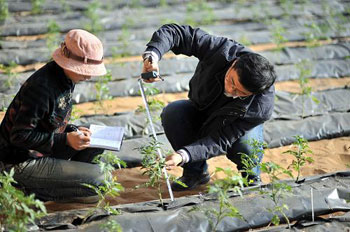Crack the "code" of rice to increase production and add legal code.
Original title: cracking the "Code" of Rice yield Regulation
If the achievements are transformed and applied, China's rice may increase by 23 million tons per year.

Three research teams, composed of Li Shaoqing of Wuhan University, Zhao Mingfu of Fujian Academy of Agricultural Sciences, Chuicai and Li Yunhai of the Institute of Genetics and Developmental Biology of the Chinese Academy of Sciences, and Zhu Xudong of the Chinese Academy of Agricultural Sciences, have recently discovered a new molecular module for regulating rice grain size and yield. Three independent papers by three research teams were published online on December 22nd in this week's academic journal Natural plants.
According to the research results, the three research teams used different methods to make growth regulators inhibited by the small ribonucleic acid molecule miR396, and together they controlled the size and number of rice grains, indicating that they may be the key to significantly increase crop yields in the future.
There are usually two ways to increase rice yield: one is to increase the number of flowers or panicles on the plant, thus increasing the number of grains; the other is to increase the size of each grain of rice. Li Shaoqing and his team found that the expression of miR396 was suppressed in hybrid rice, which in turn activated the biosynthesis and signal transduction of a plant hormone to promote panicle formation in hybrid rice.
In the study of two other research teams, the researchers found that both forms of growth factor IV (GRF4) significantly increased grain weight. They found that both forms of growth factor IV contain mutations that make them insensitive to miR396 inhibition. Chuchengcai and his research team found that increased expression of growth factor 4 activated another type of plant hormone response, which further enhanced grain development and increased grain size. Li Yunhai and his team found that growth factor 4 also increases grain size and weight by interacting with transcriptional coactivators, proteins that help activate gene expression.
All three research teams found the modules of miR396 and growth factors to regulate grain yield through multiple molecular pathways. Although both growth factor 6 and growth factor 4 are regulated by miR396, they increase grain yield in different ways, which will help guide the selection of high-yielding rice varieties in the future, the researchers said.
Zhao Mingfu said that the yield of rice is determined by the number of tillers, the number of grains per panicle and grain weight. However, in the actual breeding work, there is a very strong negative correlation among the three. In other words, when one element increases, the other two components will decrease, which is also a difficult problem for rice breeding. By means of physiology, biochemistry and genetics, the research team studied in detail the molecular mechanism of GL2 regulating rice grain size, found the specific branching pathway of important plant hormone-brassinolide in regulating rice grain size, explained the molecular mechanism of regulating rice grain size, and broke through the breeding problem that the three factors of rice yield (grain weight, number of tillers and number of grains per panicle) had positive effects at the same time. It provides very rare breeding materials and genetic resources. If this achievement is converted and applied on a large scale, it is estimated that the annual increase potential will increase rice production by 23 million tons in China and 80.74 million tons in the world according to the average yield increase of 11% in the residential area. (reporter Wang Yi Xie Kaifei correspondent Huang Xianguang)
Related
- A course of planting techniques and methods on how to grow carrots
- How to plant the latest tulips?
- Is it better to pick tea in the morning or in the afternoon? When is the best time for tea to be picked? what is the third or fifth tea?
- Launch Yuanxiao Happy combination Haocha + Tea Yuan healthy Taste
- Penghu Tourism "Fireworks 20 Parade with You"
- 2022 West Lake Happiness holds "Digital Revitalization Voucher" and draws iphone13 and laptop.
- Banqiao Fuzhou social houses are designed to change start-up combined with police elimination to create a safe and livable environment
- The convenient measure of "mechanical weeding" in Xinbei has been abused and the Agriculture Bureau has imposed heavy penalties on the illegal land consolidation.
- Changgeng University Joins Hands with Four Memory Factories to Rescue Memory Talent Shortage
- The list of Taiwan's top 100 MVP managers is listed by the Director-General of the Farmers' Association of Sanxia District.



